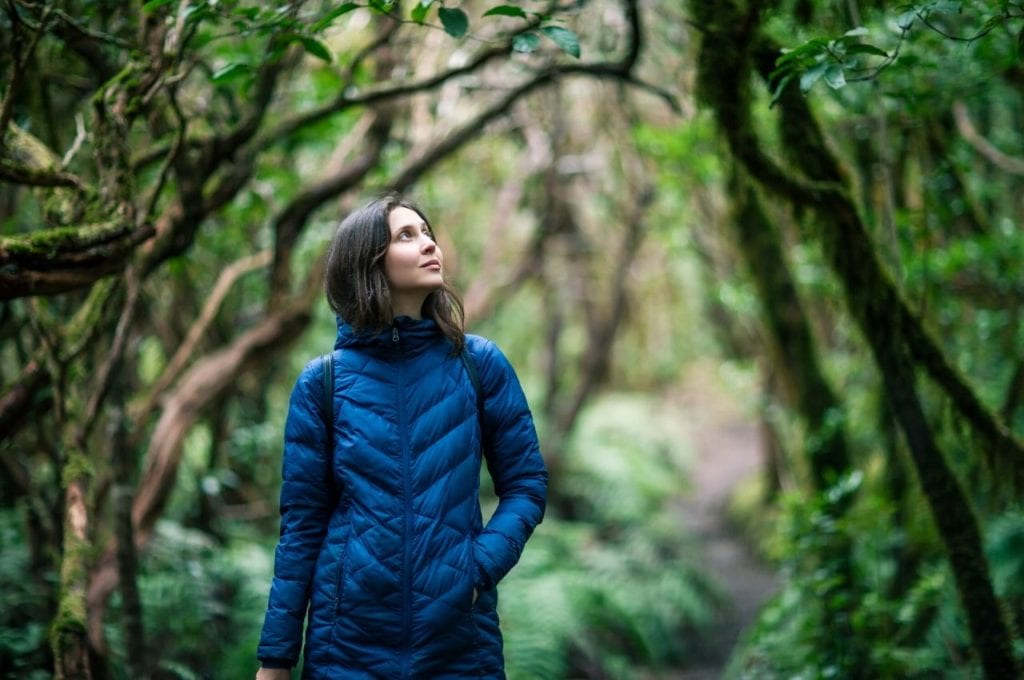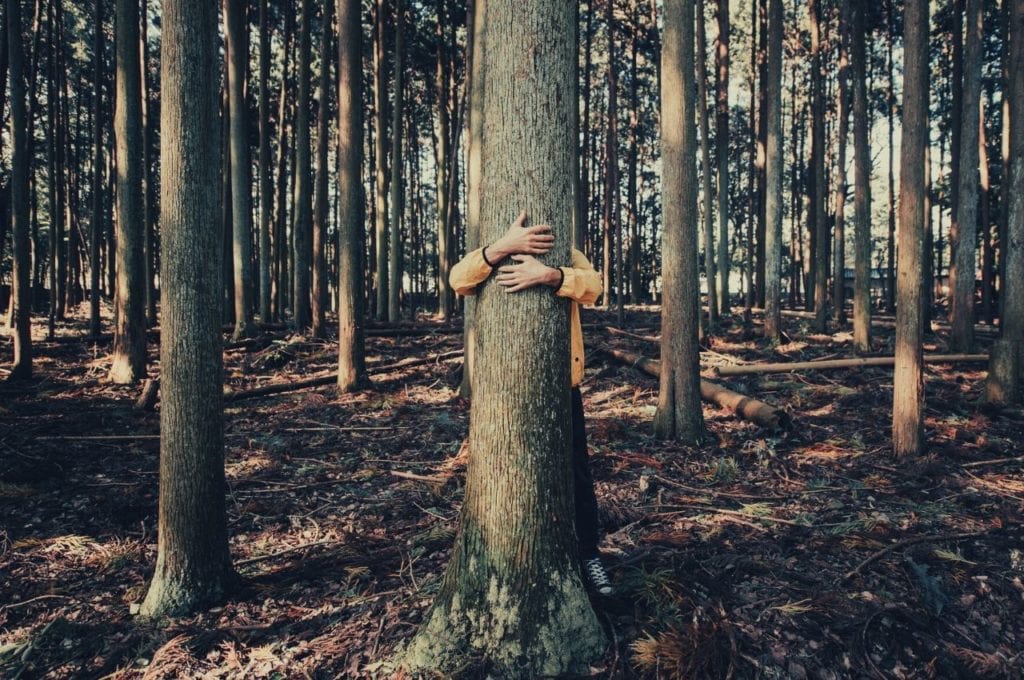Key takeaways.
-
What is "forest bathing"?
Forest bathing, traditionally a Japanese practice called shinrin-roku is the act of spending time walking through, and taking in the forest. It's a wellness practice used by the Japanese to reduce stress.
-
What happens when you add cannabis?
It adds to the magic, of course! It turns into a ritual meditation of walking through the forest, watching and breathing it in.
-
Why do forest bathing and cannabis go hand in hand?
Walking in the forest and cannabis have something in common; they're both meditative experiences. When you use cannabis in a profound, meditative environment such as the forest, you have the chance to catch profound ideas, thoughts, and feelings.
Imagine yourself sitting on a yoga mat, cross legged, in lotus position. It feels as though hours have gone by. At first, you’re relaxing to the stillness, but after a whole 3 minutes, you become distracted by pain, discomfort and… well, boredom.
The Japanese must have been reading the restless minds to the West who just can’t “figure it out” on the mat when they developed shinrin-roku, literally translating to forest bathe. In the West, we call it forest bathing.
Forest bathing was developed by the Japanese in the 1980s after the country confronted a major public health crisis. The nation was exceedingly overworked and people were dying at younger ages as a result (sound familiar?). Recognizing the inherent social dangers of this, the government set up wellness stations in the bounteous Japanese forests, and citizens were encouraged to go and dose themselves up with forest healing.
Fast forward 40 years to 2020, and the human race is working more than it ever has. Cannabis has been legalized and the coronavirus quagmire has well and truly set in. Sure, yoga, meditation, and other wellness practises are widely available - but they cost money and quite frankly, some of us just aren’t good at it. And that’s why there’s never been a better time for forest bathing than now — especially if you’re a cannabis enthusiast.
Permission to check out.

Think about it.
When you go on a holiday, you usually choose the most remote, distant locations. Empty beaches, rolling hills, and lots of good wine. There’s usually a “I’m not answering phone calls” policy. It’s a way to check out of society, your workplace, and your daily stressors. Forest bathing is permission to check out — every day.
Arguably the biggest factor causing stress to the human body and mind is this seeming inability to do precisely that — check out. The modern lifestyle is rife with constant engagement and stimulation. Every moment, there is a decision to make or a problem to solve. It’s constant firing of neurons in the sympathetic nervous system, the part of the nervous system that directs our response to stressful or dangerous situations.
Rest, which is the work of the parasympathetic nervous system, is just as integral to human health as activity. When there’s no rest, there isn’t proper digestion - or sleep, or any of the other physiological processes that require the body to be in a state of calm.
Forest bathing is essentially the conscious decision to take rest or check out. It’s the conscious choice to rest, digest on the day’s activities, and reset. And the whole world is only just starting to catch up to how important it is to our health to make that conscious decision.
Why forest bathing and cannabis go hand in hand.
For most cannabis enthusiasts, the simple act of smoking a joint is a meditation ritual in its own right. Those who use cannabis therapeutically might experience relaxation after their pain or discomfort disappears. But meditation is a different kind of relaxation all together, and more pertinent to the kind of relaxation that forest bathing can deliver.
The entire point of meditation is essentially to allow your mind a moment of stillness. It’s not just to “catch a break”, but for putting the mind in an extraordinarily flexible, malleable state that is conducive to spontaneous revelation (aka, ideas).
In a true moment of meditation, you can catch a truly profound idea — much sexier than catching a break.
For reasons researchers are still investigating, cannabis, along with a plethora of psychedelic substances, can induce this mental flexibility. You can liken it to the moments just after you wake from sleep. This is called the hypnagogic state, where you are floating somewhere between consciousness and unconsciousness.
In this state, the mind is more susceptible to ideas and divergent thinking, while the body is more sensitive to stimuli. Physical sensations can be amplified under the effect of cannabis, and the mind is less rigid in its perspectives.
Coupled with cannabis, forest bathing can be an expansive experience. It’s the kind of expanse that yogis might feel after asana practise, or that Krishna devotees might experience after a night of chanting. Cannabis provides the openness to experience, while the forest itself provides the stimuli - the experience itself.
If the forest represents all the goodness you’re trying to get into you, cannabis is a key to the portals that let it in.
How do you do forest bathing?

If you’re lucky enough to live near some of BC’s 95 million hectares of forest, forest bathing could be a daily 30 minute exercise.
Fun fact: According to the Canadian Council of Forest Ministers, “Canada is the second largest country in the world with forest or other wooded land making up 40% of its 979 million hectares. Canada's forest cover represents 30% of the world's forest and 9% of the world's overall forest cover.
So scrap that — you don’t need to live near BC to be near the forest. You can be pretty much anywhere in Canada, like Quebec, Alberta, or Ontario. So if you live near a forest, forest bathing could be something you do every day. If you live a little further, it could be a weekly meditation that goes for a little longer.
But there’s nothing really to it. You can’t fudge it. You just have to get out there — into the forest that is.
Just take a walk through the forest. Lie on the grass. Take your shoes off and let the grass get in between your toes. Unless it’s snowy, in which case, keep your shoes on. You can hug a tree, touch bark, watch butterflies, listen to birds, watch insects, find termite nests… the forest is literally your temple. And of course, if you’re so inclined, you can smoke a joint while you wander.
The idea of shinrin-roku is literally to bathe in the forest. It just means - hear the sounds of the forest, feel the things of the forest, see what lives in the forest and smell the things of the forest. You just have to let your insides and outsides be bathed by the forest. Once you step in the forest, you literally can’t make a mistake.
Don’t take our word for it…
Hopefully by now, you’re convinced that enlightenment isn’t confined to the yoga mat or the meditation cushion. Though they are increasingly popular ways of finding that tender inside zone, they aren’t the only way. And you should never underestimate the enlightening power of a walk through the forest.
Now the only way left to know what’s really up with cannabis and forest bathing is to jump onto the My Supply Co. store, browse for a delicious cannabis product, and get into the forest (we seriously recommend Moby Dick for this kind of adventure).
Let us know in the comments what forest bathing felt like for you, and what kind of epiphanies and revelations reveal themselves on the journey.